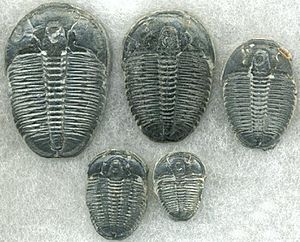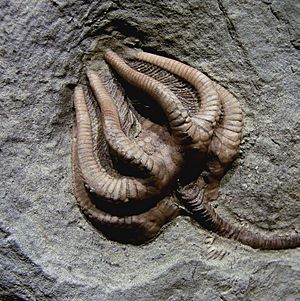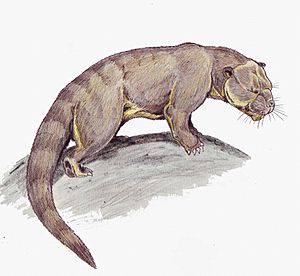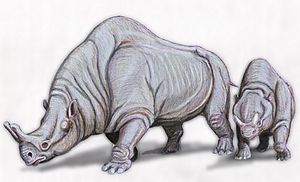Prehistory of the United States facts for kids
The prehistory of the United States covers the time from when the Earth formed until people started writing down history in the areas that are now the United States.
Long, long ago, during the Paleozoic era, what we now call North America was actually in the southern part of the world. The seas were full of amazing marine life. But there was no life on land yet. Later in the Paleozoic, many seas turned into swamps. These swamps were home to early amphibians and reptiles. When all the continents joined together to form Pangaea, the land became much drier. Creatures that were like early mammals ruled the land. But then, a huge event caused many species to die out.
After that came the Triassic period, the first part of the Mesozoic era. This is when dinosaurs first appeared and quickly spread into the United States. Soon, Pangaea started to break apart. North America slowly moved north and west. During the later Jurassic period, the western states had huge floodplains. Dinosaurs like Allosaurus, Apatosaurus, and Stegosaurus lived there.
In the Cretaceous period, the Gulf of Mexico grew so large it split North America in half! Giant marine reptiles like plesiosaurs and mosasaurs swam in its waters. Later, this sea began to shrink. The coastal plains of the western states became home to famous dinosaurs. These included Edmontosaurus, Triceratops, and Tyrannosaurus. Another mass extinction event then ended the age of dinosaurs.
The Cenozoic era began after the dinosaurs disappeared. The huge inland sea from the Cretaceous period slowly vanished. Mammals began to take over the land. During the Eocene epoch, the western states had small, early camels and horses. There were also meat-eating animals called creodonts. Soon, some mammals moved into the oceans. Early whales like Basilosaurus swam in the coastal waters of the southeast. Rhino-like titanotheres were common in South Dakota during the Oligocene. From this time on, the climate in the United States got colder. This led to the Pleistocene Ice Age, when glaciers spread across the land. Saber-toothed cats, woolly mammoths, mastodons, and dire wolves roamed the land. Humans arrived by crossing a land bridge between Siberia and Alaska. They might have helped hunt some of these large animals to extinction.
Contents
Precambrian Era: Earth's Earliest Life
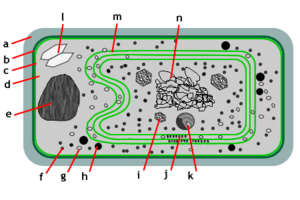
The oldest known complex cells, called eukaryotes, lived about 1.4 billion years ago. They were found near Beck Spring, California. These tiny organisms used photosynthesis to make their food. A cool byproduct of this process was oxygen! The oxygen they released made our planet's air breathable for us today.
You can find remains of these ancient blue-green algae in Michigan. They are preserved between Copper Harbor and Eagle Harbor, along the shore of Lake Superior. After these first complex cells appeared, more complicated multicellular life began to show up. Rocks in Nevada, dating back a billion years, show signs of ancient worms. These worms left behind trace fossils as they burrowed in the mud. Other complex Precambrian life forms have been found in North Carolina and Arizona.
Paleozoic Era: Life in Ancient Seas
The Phanerozoic eon started after the Precambrian. The first big part of this eon was the Cambrian period, within the Paleozoic era. Back then, Earth's continents looked very different. They were generally smaller than they are today. The southeastern part of the US was connected to South America and Africa. It was located near the South Pole. The western states were closer to the equator.
All known life during the Cambrian lived in water. So, any parts of the United States above sea level would have been empty land. Trilobites are the most common animals found from the Cambrian period. The Elrathia trilobites from Utah's Antelope Springs are very famous. Sponge-like creatures called archaeocyathids were common in Nevada. Brachiopods, snails, and sponges were also important Cambrian animals.
Sea levels around North America dropped at the end of the Cambrian. This probably destroyed many shallow water ecosystems. The Cambrian period ended with a mass extinction. Many types of brachiopods, snails, and sponges disappeared. Almost three-quarters of trilobite families vanished.
Ordovician Period: New Sea Creatures Appear
Much of the continent was covered by water again when the sea rose in the Ordovician period. The most common animal found from this time was the brachiopod. Many of them lived and were preserved in great detail near Cincinnati. You can find these fossils in Indiana, Kentucky, and Ohio. Most Ordovician trilobites were different from their Cambrian ancestors. The few types that survived the extinction event grew into many new kinds.
During the Middle Ordovician, early armored, jawless fish called ostracoderms left bone fragments. These are found in the Rocky Mountains region. Late in the Ordovician, sea levels dropped again. Another mass extinction ended the Ordovician period. About 25% of all animal families disappeared worldwide. Brachiopods, fish, sea urchins, sponges, and trilobites suffered big losses. Trilobites were hit hardest, losing 50% of their families.
Silurian Period: Coral Reefs and Salt Beds
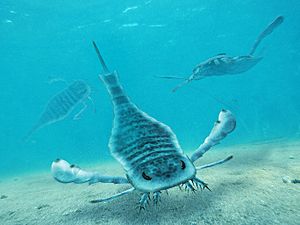
During the Silurian period, warm, shallow seas covered most of North America. Illinois, Indiana, and Michigan were home to huge coral reefs. The reefs in Indiana are some of the most diverse from this period. The southeastern United States was still part of a supercontinent called Gondwanaland.
As the Silurian period went on, the seas covering most of the country began to shrink. Only the Michigan and New York areas, which were near the equator, remained underwater. However, these trapped seas were not refilled by fresh water. They slowly evaporated, leaving behind thick layers of salt in those regions.
Devonian Period: Age of Fish and Early Forests
Devonian North America was again covered by seas full of life. In fact, marine life during the Devonian might have been more abundant and diverse than at any other time in the Paleozoic. Glass sponges became common in western New York. The marine fossils of Cuyahoga County, Ohio, are especially famous. They show more than 120 kinds of marine life. Over 50,000 fish fossils alone have been found there.
During the Late Devonian, the oldest known seed-bearing plants grew in Pennsylvania. These plants might have been seed ferns. They looked like ferns but reproduced using seeds instead of spores. The Gilboa Fossil Forest in New York, one of the first forests in the world, formed around this time. The Devonian period ended with another mass extinction. About 25% of all families were lost. Almost every family of ammonoids, fish, and amphibians died out. Most known families of coral and trilobites also disappeared.
Mississippian and Pennsylvanian Periods: Crinoids and Giant Insects
The Mississippian period is sometimes called the "Age of Crinoids." This is because these animals left behind so many fossils. Other common life forms included their relatives, the blastoids. Tiny, pinhead-sized creatures called Endothyra were also very common. Some limestones in Illinois and Missouri are almost entirely made of their remains. Few land animal fossils are known from the Mississippian in North America.
During the next period, the Pennsylvanian, the supercontinent Gondwanaland finally joined North America. This was part of the formation of Pangaea. Mountains, called the Ancestral Rockies, rose in Colorado, Utah, and Wyoming. The seas left the middle of the country. Instead, huge, thick swamps covered large areas. The biggest insects in Earth's history lived during the Pennsylvanian. Giant salamander-like amphibians left footprints in Kansas that later became fossils. Fossil footprints from this time are also found in eastern states like Alabama, Georgia, and Pennsylvania.
Permian Period: Reptiles Rise and the Great Dying
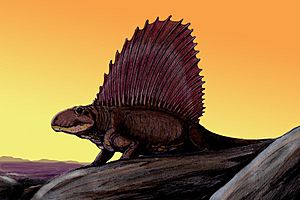
All the world's continents were joined together as Pangaea throughout the Permian period. Volcanic activity happened on the west coast. Seas were present in the southwest and along the west coast. The seas of Texas had huge reefs made of spiny brachiopods. Seas that once covered Kansas, New Mexico, and Texas began to dry up, leaving behind salt deposits. The inner parts of the western United States had a hot, dry climate. Sand dunes were common.
Permian insects were common and diverse, though smaller than those from the Pennsylvanian. For example, 20 different types of insects were preserved at a site called Insect Hill in Kansas. Large amphibians were found in the southwestern United States, but they had to stay close to water. Seymouria was a 20-inch-long animal from Texas. It was a transitional form, showing how reptiles evolved from amphibian-like ancestors. Reptiles became common during the Permian. Texas was also home to Dimetrodon and Edaphosaurus, which were pelycosaurs. Later in the Permian, therapsids became the main large land animals. These were the ancestors of mammals.
The Permian period ended with the most destructive mass extinction in Earth's history. Up to 96% of all species may have disappeared worldwide. Many types of corals, bryozoans, brachiopods, and ammonoids died out. Eurypterids (sea scorpions) and trilobites became completely extinct. Blastoids also disappeared. Crinoids lost almost all their families. Only one type of sea urchin is known to have survived. The animals that survived were usually small creatures that ate dead material or sediment. The biggest losses were among filter feeders and meat-eaters.
Mesozoic Era: The Age of Dinosaurs
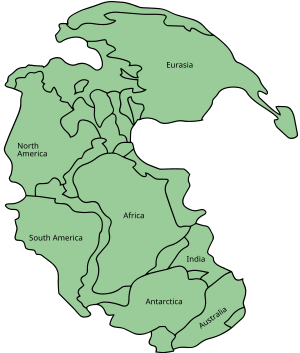
For most of the Triassic period, the eastern United States was part of the inside of Pangaea. At that time, the area was near the equator. It was connected to western Europe and Africa. When all the continents joined into one huge landmass, it changed how the atmosphere and oceans moved. This made the eastern US have a hot climate with strong seasons. Much of the country was located around 30 degrees North latitude. This area usually has high air pressure and little rain. The western United States was mostly covered by seawater during the Late Triassic. Mountains were forming, and volcanoes were active in that same region.
The Triassic period saw Earth's living things recovering from the huge extinction at the end of the Permian. After that extinction, ammonoids were among the first marine animals to become common again. During the Middle Triassic, the types of corals we see in modern oceans appeared. Corals were rare in North America during the Triassic. However, some were found on the west coast, though they didn't form large reefs. Ichthyosaurs were very important marine reptiles during the Triassic. Important ichthyosaur fossils from this time have been found in Nevada.
On land, North America's plants included conifers, cycads, ferns, ginkgoes, and horsetails. The plants on the east coast showed that there were swampy areas in the local rift valleys. Arizona was home to a huge forest that later became the famous petrified wood. Reptiles began to dominate land, sea, and air during the Triassic. This is why the Mesozoic is called "the Age of Reptiles."
Dinosaurs Appear!
The Late Triassic also saw the first dinosaurs. Dinosaurs left many fossils in the Four Corners region. This area is now one of the best places to find Late Triassic dinosaur fossils in the United States. Texas is also a good source of dinosaur remains from this time. The oldest dinosaur remains in the eastern US are about 225 million years old. So, dinosaurs reached the east coast of the United States not long after they first evolved. Fossil footprints are the most common type of early dinosaur fossil found in the eastern United States.
As the Triassic ended, Pangaea began to break apart into separate continents again. Rift valleys formed along the east coast as the North American, European, and African plates moved away from each other. This process created rifts down the east coast to Florida. One of these rift valleys filled with ocean water and became the young Atlantic Ocean. Volcanoes related to Pangaea breaking apart also left deposits in the eastern US. At the end of the Triassic, another mass extinction happened. This event wiped out about a quarter of all animal families worldwide. Conodonts became completely extinct. Ammonoids barely survived. Brachiopods also lost much of their diversity. On land, most families of amphibians and reptiles died out.
Jurassic Period: Giant Dinosaurs Roam
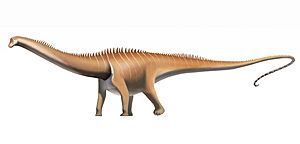
The eastern coast of the US became warmer and wetter during the Early Jurassic. This was because the new Atlantic Ocean brought more humid air. Fossils from the Late Triassic to Early Jurassic are found in the Newark Supergroup. This rock unit stretches from Nova Scotia in Canada to South Carolina. Rifting continued in the eastern part of the country as the eastern United States moved away from Greenland and Europe. The Pacific Plate pushed under the North American plate. This caused geological changes, including volcanoes, on the west coast. Ichthyosaurs were the main marine reptiles in the Early Jurassic. But as the Jurassic went on, plesiosaurs gradually became more dominant.
The Morrison Formation is a famous rock layer deposited during the Late Jurassic. These rocks are now found in Arizona, New Mexico, Utah, Colorado, Wyoming, and other western states. At that time, this region had forests of conifers, ginkgoes, and tree ferns. Coal later formed from these plants. Mammals in this area became much more diverse during the Jurassic. The Morrison Formation is the best place to find Jurassic mammal fossils in North America.
Local dinosaurs included the plant-eating ornithopod Camptosaurus. Huge sauropods like Apatosaurus and Diplodocus also lived there. The meat-eating theropod Allosaurus was also present. Unlike many other periods, the Jurassic did not end with a mass extinction. However, there were smaller extinction events. Some ammonoids and dinosaurs disappeared during this time.
Cretaceous Period: Inland Seas and T. rex
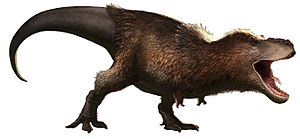
During the Early Cretaceous, the Gulf of Mexico slowly began to expand northward. On land, the eastern United States looked like the modern Mississippi Delta. It was a low, flat plain with many rivers. Thick plants covered the region. These included club mosses, conifers, cycads, ferns, ginkgoes, horsetails, and early flowers.
During the Late Cretaceous, the Gulf of Mexico had expanded across North America all the way to Alaska! Up to half of the continent's modern land area might have been underwater. This huge sea is called the Western Interior Seaway. It covered most of Texas, New Mexico, Colorado, Kansas, and the Dakotas. The seafloor was flat and probably never deeper than 600 feet. Many different invertebrates lived both on the bottom and in the water. These included ammonites, giant clams, crinoids, and squid. Vertebrate life included bony fish, mosasaurs, plesiosaurs, sharks, and turtles.
Areas now covered by the plains of the east coast, from New Jersey south, were underwater during the Cretaceous. Sea levels reached their highest point in all of Earth's history during this period. However, they dropped before the period ended. Corals were more diverse during the Cretaceous than they are today. Coral reefs formed along the Gulf coast. Another type of clam, Exogyra, was so common that its fossils are found in almost every Cretaceous marine deposit. During the Cretaceous, the most common group of living fish, the teleosts, became dominant. The aquatic, toothed bird Hesperornis is the only known Cretaceous bird whose remains are often found in North America.
Near the end of the Cretaceous, the Western Interior Seaway began to shrink. This caused the two halves of North America to rejoin. As the seaway pulled back, a coastal plain grew southward in the western interior. Strong geological forces began to fold and twist the rocks of Idaho, Utah, and Wyoming. This started the process that would form the Rocky Mountains. Rivers flowing across eastern Montana deposited the sediments now known as the Hell Creek Formation. At that time, Montana was home to some of the most famous dinosaurs. These included Edmontosaurus, Pachycephalosaurus, Triceratops, and Tyrannosaurus. Despite the changes in the west, the eastern US was geologically stable by the Late Cretaceous. The weather was warm and rainy all year. Flowering plants were common. Fossils of broadleaf trees and shrubs are found in Late Cretaceous rocks.
The End of the Dinosaurs
The Cretaceous period ended with another mass extinction. This was the second most devastating in Earth's history. About half of all animal families became extinct. Ammonoids and belemnoids (squid-like creatures) disappeared from the oceans. Two-thirds of coral species died out. About half of sponge families became extinct. Clams, bryozoans, and snails also suffered heavy losses. The major Mesozoic marine reptile groups, like mosasaurs and plesiosaurs, became extinct. On land, the non-bird dinosaurs and pterosaurs (flying reptiles) also died out.
The most popular idea for this mass extinction is that a huge meteorite hit Earth. This impact would explain why there are high levels of a heavy element called iridium in sediments from that time. Iridium is very rare in Earth's crust but much more common in meteorites. Dinosaur fossils are found in many states across the modern United States.
Cenozoic Era: The Rise of Mammals
After the Cretaceous, a new era began: the Cenozoic era. This name means "recent life." The Cenozoic is divided into the Paleogene and Neogene periods. Geological activity continued on the west coast. The Pacific Plate kept sliding under the North American Plate. During the early Cenozoic, climates were much warmer than today. Even places as far north as South Dakota had a subtropical climate until the end of the Oligocene.
Sea levels fell throughout the Cenozoic. Areas of Cenozoic North America that were underwater were usually near the modern coasts. The Cannonball Sea near Minot, North Dakota was the last inland sea in North America. Cenozoic marine invertebrates are best known from coastal deposits. They often look like modern forms. Solitary corals became common, but coral reefs only formed around the Gulf of Mexico. Sharks were common during the Cenozoic. From Eocene times onward, they began to grow larger.
The beginning of the Cenozoic was also the start of the "Age of Mammals." Small, shrew-like insectivores survived the Late Cretaceous extinction. They then began to evolve into the many different mammals that dominate Earth's land today. The creodonts, which first appeared in the Paleocene, were among the first mammals to specialize in eating meat. The coastal areas of southeastern states, like Alabama and Mississippi, were covered by seawater. The primitive whale Basilosaurus lived there during the Eocene. The number of different meat-eating mammals on land increased from the Eocene to the Miocene.
Mammals Grow and Evolve
Around the same time, camels became common in North America. However, they were only a bit bigger than modern rabbits during the Eocene. Early camels had four toes. During the early Eocene, the first primitive horses also appeared. One of the earliest was Eohippus, a small animal with four toes on its front feet and three on its rear feet. A group of mammals called oreodonts also appeared during the Eocene.
By the Oligocene, camels were the size of sheep and had only two toes. Over time, horses also lost toes. Unlike camels, horses' toes were reduced to a single digit. By the Oligocene, their teeth had adapted to chew tough, grassy diets. Horses gradually became common across the country. Many oreodonts grazed in the badlands of South Dakota by the middle of the Cenozoic. Oreodonts looked a bit like pigs and were about the size of modern goats. Their numbers were highest during the Oligocene. The largest mammals of Oligocene North America were the rhinoceros-like titanotheres. One amazing example was the common Brontotherium from South Dakota. It could be up to 8 feet tall at the shoulder! Despite their early success, this entire group became extinct by the end of the epoch.
Ice Ages and Early Humans
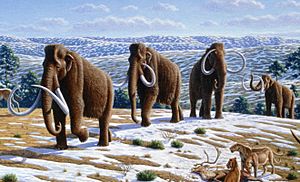
After the Oligocene, temperatures began to drop. Warm-weather plants were forced southward. By the Miocene, some sharks, which had been growing larger since the Eocene, were over 60 feet long! Mastodons arrived in North America by crossing the Bering land bridge from Asia during the Miocene. The oreodonts became extinct during the Pliocene. By the end of the Pliocene, more modern carnivores like wolves and cats appeared. Famous among these were the saber-toothed cats.
Woolly mammoths became common across the US during the late Cenozoic. During the late Pleistocene Ice Age, huge amounts of water were frozen in glaciers. This caused sea levels to drop, revealing a land bridge between Asia and Alaska. Humans crossed over this bridge and became common in North America between 11,000 and 12,000 years ago.
Despite surviving the changing climate and glaciers, about 32 types of large mammals suddenly became extinct around 10,000 years ago. Horses disappeared from North America during these extinctions of large Ice Age animals. Some scientists believe that early humans caused these extinctions by overhunting the large animals. Under this idea, the saber-toothed cats and other predators would have died out because their main food source disappeared. However, this explanation is still debated by scientists.


